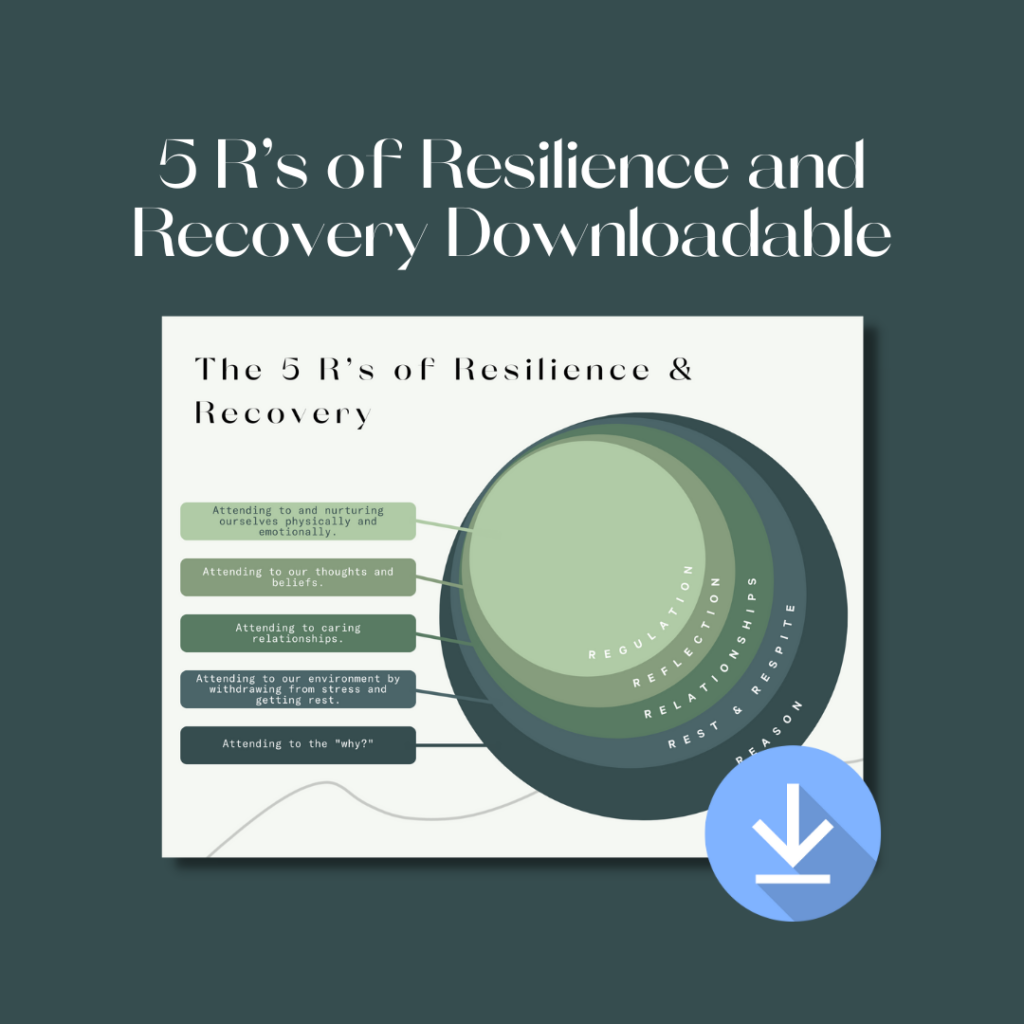You might not know it, but we are all trauma survivors
Many of us have very personal traumatic experiences that are part of our survival stories, but together we all have faced the impact of the threat of COVID-19 and other major events in our lives and bodies. The results of our experiences can be as serious as diagnosable post-traumatic stress disorder or clinical depression, but they can also result in reactions like sadness, substance use, irritability, hostility, exhaustion, emotional withdrawal, social isolation, and physical symptoms such as GI or cardiovascular problems.
Why do some people weather life’s storms better than others?
There are things we can do to help ourselves recover from and develop resilience to seasons of struggle and threat. You probably are engaging in some of them already, but it is helpful to pay attention to what you are doing, and understand what you may be missing. We can all benefit from incorporating practices in our lives that connect with these 5 areas: regulation, reflection, relationships, respite and rest, and reasons. This framework provides a structure for engaging in practices in your life to help you negotiate through seasons of disruption and hardship. Click the link for a summary of the practice –The 5 R’s of Resilience and Recovery.
Regulation
Let’s start with the very core of things. The basis of our day-to-day living is controlled by our nervous systems. God made us with this incredible system of neurons that are firing all the time and telling our bodies to breathe, digest, react, rest, get moving, or stop and wait. Much of this happens outside of our awareness or attention and occurs automatically. But, we can begin to manage that complex system by engaging in practices to move us from the fight/flight sympathetic nervous system to the rest/recovery parasympathetic nervous system. A pathway to access the rest/recovery system is through the body. Practices help us override these automatic responses and create new neurological habits. Here are some recommendations of practices that help forge new pathways for your body to cultivate more resilient responses.
Pathway to regulation: Physical Regulation
Ask yourself – Do I feel tense and clenched? Are my shoulders up around my ears? Is my stomach upset or in a knot? Am I feeling relaxed? Light hearted? Am I tired? These are important questions and the body provides important clues about what we might need. A simple thing to do is to stop at any time of the day and notice if your shoulders are drawn up and clenched around your neck. If they are, allow them to release and draw them back down. Take a slow deep breath, intentionally bringing relaxation to the body. Click the links below to take you through more detailed practices around physical regulation.
Pathway to Regulation: Emotional Regulation
Ask yourself – Do I know what I am feeling? What emotions am I experiencing? The body might be giving us clues that we are feeling something we need to name. The idea of emotion regulation is not that we try to “stamp down” the emotions that we are feeling. Instead, learning successful emotion regulation means that we are able to name the emotion (think of all those emojis!), non-judgmentally reflect on what the emotion might be telling us, and then make plans on how to respond to our needs, even as we feel the emotion. Feel the feeling, in the midst of moving forward with our lives. It is accepting that the feeling is there for a reason, and has something to teach us.
Click here for a link to my practice to help with emotion regulation.
Physical and emotional regulation are powerful tools for building resilience. Attending to what we feel in our bodies helps us to connect to our emotional experience. While our emotions are embodied, they also connect to how we are thinking and to our deepest sources of meaning. In my own life, emotions are my allies. They are signposts or indicators of how I am doing and what matters.
Reflection
Consider a time when you felt like a loved one did something that really hurt your feelings, but then later you found out that you had misunderstood. Perhaps it was a comment that seemed critical, or maybe you felt excluded from an event, or perhaps you believed you were betrayed in some way. When you found out the “truth” about the experience – say you heard something incorrectly, or you made an incorrect assumption – did the “truth” you discovered change what you believed about the situation? Often discovering new information alters how we feel. We can still feel the sting, but the clarification changes our interpretation of the situation and helps us to let go or de-escalate the hurt.
In a similar way, what we believe can also increase our pain. Whether these are beliefs about ourselves, others, or the world, our core beliefs can cause increased hurt (or the opposite, but we will get to that in a bit). For example, during the pandemic, I was surprised at how quickly people would criticize themselves for feeling tired or unproductive. Limited energy is a natural response to a protracted crisis situation. At the beginning of a crisis we are on high alert. Over time our bodies cannot continue to remain at elevated levels of arousal. It is natural to be fatigued, to have difficulty concentrating, and to be less productive. When we believe “something is wrong with me because I cannot get things done,” or we ask ourselves “why am I having so much trouble keeping up?”, we add self-criticism and shame to the mixture. Now we are no longer just tired. We are tired, ashamed, and depressed.
This is why Reflection (or right-thinking) is so important. We need to pay attention to the messages we tell ourselves. Do these messages reflect the truth? Or are they messages that connect to lies, familial or other cultural expectations that we erroneously accept? As you practice paying attention to your emotions, you can add the step of asking, “what is the story I am telling myself about this situation?” Or you may ask “what is the lie that I am believing in this situation?” Then ask, “what do I know is true?” or “what might be a more accurate story?” Christians may ask, “how does the God of love and grace see this story?”
Relationships
We are designed to engage in relationships with others! We are connected to people in our families, in friendships, in work relationships, and in other communities. We are also connected in relationship to the divine, as we pray, contemplate, worship, and serve others.
We all need particular relationships in which we can truly be ourselves. We need people who can hear our stories, accept us, and reflect back to us what is true. We need to know and be known, love and be loved. One of the painful aspects of surviving traumatic experiences is the way that trauma can cause us to withdraw or pull away from relationships. We may be concerned that we are “too broken,” or we may feel ashamed of our experience. Perhaps we have experienced responses from others that re-traumatize us, or leave us feeling more disconnected and alone. In some cases, we may need to separate from relationships that have been hurtful or abusive. All these together can lead to situations where we avoid intimacy with others. It can be difficult to regain trust, or to find trustworthy people again. Yet, one of the primary sources of resilience in the face of trauma is social support. We heal when we feel cared for, and when we care for others.
That is why I would suggest that an important part of Resilience and Recovery is paying attention to how you are relating to others. How much time are you spending with people who love you? How much time are you spending with people who do not love you? How honest are you with the trustworthy friends in your life? What might it look like to make honest, genuine sharing a priority for you and for your loved ones? If you are not being honest, take a hard look at why not. Your answers may point toward pathways of healing and identify places where you need extra support.
We need to make time in our schedules to prioritize the loving relationships in our lives. Time away from work and time away from traumatic triggers are other key aspects of resilience to and recovery from trauma.
Respite and Rest
I find it fascinating that keeping Sabbath is one of the Ten Commandments, right up there with do not murder, steal, or commit adultery. I guess we could say that our divine maker knows that rest must be part of a functioning life. Not resting, not honoring the holy in the Sabbath space, distorts us and keeps us from God. It’s shocking to think that distortion and separation from God through a lack of rest would be as damaging to us as an act of murder. How might our lives and our faith communities be different if we kept the Sabbath, or if we trusted God to take care of life, so that we might rest?
The reality is that we need breaks, breaks from the burden of struggle and breaks to physically rest.
Respite is creating an intentional break from exposure to stress and trauma. Ask yourself, how much traumatic material do I see in the media or in the work that I do? How much pressure and stress do I feel in my workplace? What can I do to take a moment away from the stress to calm down (and practice physical regulation)? How can I give my nervous system a break and not feel always on? How can I limit the triggering material that I take in through different sources? We all need to attend to the stress and trauma we are exposed to, and we do not need to be apologetic about setting boundaries on the exposure that we can control or limit.
Rest is then attending to the rhythm of rest and recovery in our lives. We are not made to be machines, functioning with no down time. Are you paying attention to the amount of sleep you are getting at night? Are you taking some time away from work? Do you have a Sabbath in your week?
There are many reasons why we might have schedules that make taking a longer break feel impossible. It may be that you are a parent, or perhaps a single parent, and there are not a clear ways to break from the ongoing responsibilities of work and parenting. Keeping Sabbath may be something that you approach creatively with a prayerful heart to discover what rest can look like for you. It may also mean reaching out to your loved ones to support your needs for rest.
Keeping the Sabbath is also not only about physical, emotional, and mental rest; it is also about paying attention to our spiritual needs. “Remember the Sabbath and keep it holy,” is the commandment. This is an invitation to claim your time, rest, and attention as a sacred commitment. It is a reminder of the Reasons, or purpose of our efforts.
Reasons
Humans are meaning-making creatures. We want to understand “why” things happen (picture the incessant questions of a three year-old child!). Understanding, or “making sense” of something, helps us to navigate our worlds. For many of us, there is also a drive to connect with something beyond ourselves – a transcendent meaning for our lives and our experiences. We want a reason for why things happen and an understanding of the significance for our lives.
When traumatic events happen, this drive to understand, or feel in control of a situation, can become even more complex. So many of life’s traumas do not have clear reasons or explanations. We want to understand the “cause” so that we can figure out how to avoid the same loss or trauma in the future. We also want to know that the events of life fit into something bigger. That they have significance; that they mean something.
How might we practice something that seems so existential? I recommend engaging in rituals or practices to connect to the transcendent – something bigger than we are – that provides a source of meaning.
- We can participate in spiritual activities or a faith tradition.
- We may feel a sense of purpose or calling for a particular occupation or vocation. This calling can be the reason to do difficult work, to be present in parenting, or the calling can be a way to connect with a sense of divine relationship.
- We can reflect on the things that we value that point beyond ourselves – e.g. justice, beauty, love.
- We can meditate or pray.
- We can lament – as a way to express to a transcendent divine presence about the ways that life does not “make sense.”
- We can spend time in nature.
Next steps
You may have noticed the 5 R’s generally flow from inside your body, to those around you, to your environment, and to the transcendent that is beyond us. The practice of the 5 R’s grows in concentric circles, but the pattern between the R’s is not fixed. This practice reminds us that we are engaging in our lives both individually and communally. The R’s do not exist in exclusive categories. We practice in ways that can provide Regulation and Respite, Relationships and Reasons, or so many other combinations. For example, you may participate in a contemplative prayer practice, which creates a respite from the daily stressors, allows for physical regulation through mindful breathing, creates a relational connection to the divine, and ultimately places you in a space of openness to the transcendent.
As you think about your own resilience and recovery to our communal trauma, here are some questions to consider:
- What are the practices that you have in your life that touch on these five areas?
- How often are you engaging in them?
- Are there certain R’s that are more easily accessible to you?
- How might you incorporate another “R” in your life?
Incorporating practices from the 5 R’s is going to look different for everyone. Your personality and temperament, cultural context, your resources, and your community will all contribute to the practices that fit for you. For example, for a Latina friend, spending time chopping the ingredients and cooking a big family dinner is an important way to create respite, be physically regulated with focused and rhythmic activity, and ultimately enjoying the connection with family members. Or, you might recognize that you settle and regulate more easily by being outside, which could lead to a daily practice of mindful walking and breathing. The main thing is that you pay attention to these areas, and you lean into developing your own rhythms and habits that can help you to continually recover from the ongoing challenges, move forward, and develop resilience for the future!

YOUR FREE DOWNLOAD
Here’s a printable PDF of Dr. Eriksson’s 5 R’s of Recovery and Resilience to serve as a daily reminder to practice self-care during difficult and stressful times.
Download now.
Continue Exploring

Resilience
A Practice: The Five R’s of Resilience and Recovery
Cynthia Eriksson's psychological and theological framework points to 5 self-care practices to developing resilience and recovery.

Blog
Helping Kids Develop Coping-Resiliency Strategies During Life Challenges
Thrive Fellow, Esther Tan shares a research-based model to understand how we can support kids in times of uncertainty.

Agility
A Practice: The Five A’s for Agility in the Face of Change
Finding joy requires practice. Learn how you can be agile and experience more joy in your daily life through our 5-step process.

